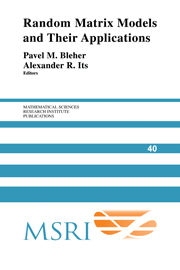Book contents
- Frontmatter
- Contents
- Preface
- Symmetrized Random Permutations
- Hankel Determinants as Fredholm Determinants
- Universality and Scaling of Zeros on Symplectic Manifolds
- z-Measures on Partitions, Robinson-Schensted-Knuth Correspondence, and β = 2 Random Matrix Ensembles
- Phase Transitions and Random Matrices
- Matrix Model Combinatorics: Applications to Folding and Coloring
- Interrelationships Between Orthogonal, Unitary and Symplectic Matrix Ensembles
- Dual Isomonodromic Tau Functions and Determinants of Integrable Fredholm Operators
- Functional Equations and Electrostatic Models for Orthogonal Polynomials
- Random Words, Toeplitz Determinants, and Integrable Systems I
- Random Permutations and the Discrete Bessel Kernel
- Solvable Matrix Models
- The τ-Function for Analytic Curves
- Integration over Angular Variables for Two Coupled Matrices
- Integrable Lattices: Random Matrices and Random Permutations
- SL(2) and z-Measures
- Some Matrix Integrals Related to Knots and Links
Matrix Model Combinatorics: Applications to Folding and Coloring
Published online by Cambridge University Press: 25 June 2025
- Frontmatter
- Contents
- Preface
- Symmetrized Random Permutations
- Hankel Determinants as Fredholm Determinants
- Universality and Scaling of Zeros on Symplectic Manifolds
- z-Measures on Partitions, Robinson-Schensted-Knuth Correspondence, and β = 2 Random Matrix Ensembles
- Phase Transitions and Random Matrices
- Matrix Model Combinatorics: Applications to Folding and Coloring
- Interrelationships Between Orthogonal, Unitary and Symplectic Matrix Ensembles
- Dual Isomonodromic Tau Functions and Determinants of Integrable Fredholm Operators
- Functional Equations and Electrostatic Models for Orthogonal Polynomials
- Random Words, Toeplitz Determinants, and Integrable Systems I
- Random Permutations and the Discrete Bessel Kernel
- Solvable Matrix Models
- The τ-Function for Analytic Curves
- Integration over Angular Variables for Two Coupled Matrices
- Integrable Lattices: Random Matrices and Random Permutations
- SL(2) and z-Measures
- Some Matrix Integrals Related to Knots and Links
Summary
We present a detailed study of the combinatorial interpretation of matrix integrals, including the examples of tessellations of arbitrary genera, and loop models on random surfaces. After reviewing their methods of solution, we apply these to the study of various folding problems arising from physics, including: the meander (or polymer folding) problem “enumeration of all topologically inequivalent closed nonintersecting plane curves intersecting a line through a given number of points” and a fluid membrane folding problem reformulated as that of “enumerating all vertex-tricolored triangulations of arbitrary genus, with given numbers of vertices of either color”.
1. Introduction
Our first aim of this article is to convince the reader that matrix integrals, exactly calculable or not, can always be interpreted in some sort of combinatorial way as generating functions for decorated graphs of given genus, with possibly specified vertex and/or face valencies. We show this by expressing pictorially the processes involved in computing Gaussian integrals over matrices, what physicists call generically Feynman rules. These matrix diagrammatic techniques have been first developed in the context of quantum chromodynamics in the limit of large number of colors (the size of the matrix) [1; 2], and more recently in the context of two-dimensional quantum gravity, namely the coupling of two-dimensional statistical models (matter theories) to the fluctuations of the two-dimensional space into surfaces of arbitrary topologies (gravity) [3]. These toy models for noncritical string theory are a nice testing ground for physical ideas, and have led to many confirmations of continuum field-theoretical results in quantum gravity.
Information
- Type
- Chapter
- Information
- Random Matrix Models and their Applications , pp. 111 - 170Publisher: Cambridge University PressPrint publication year: 2001
